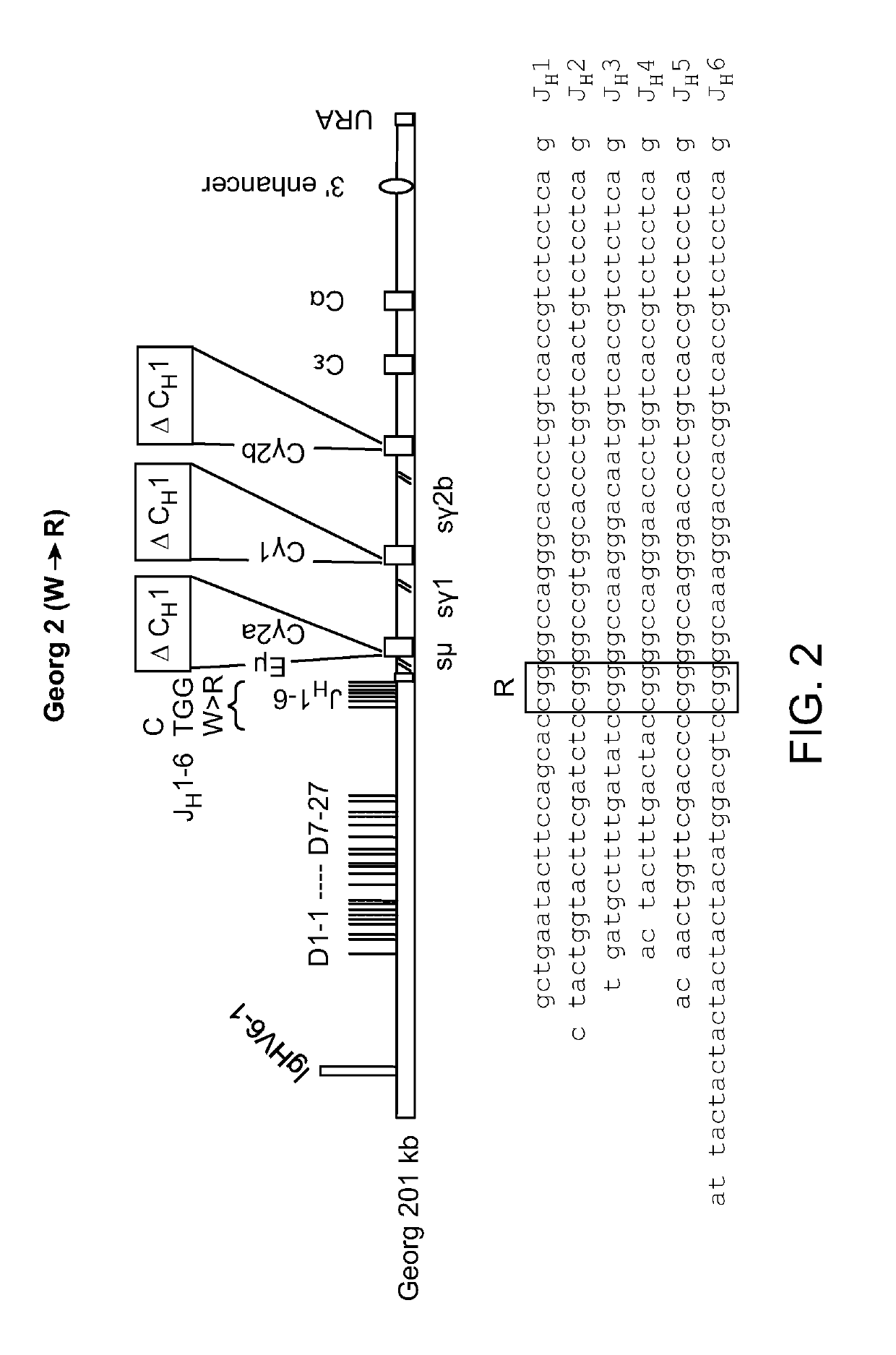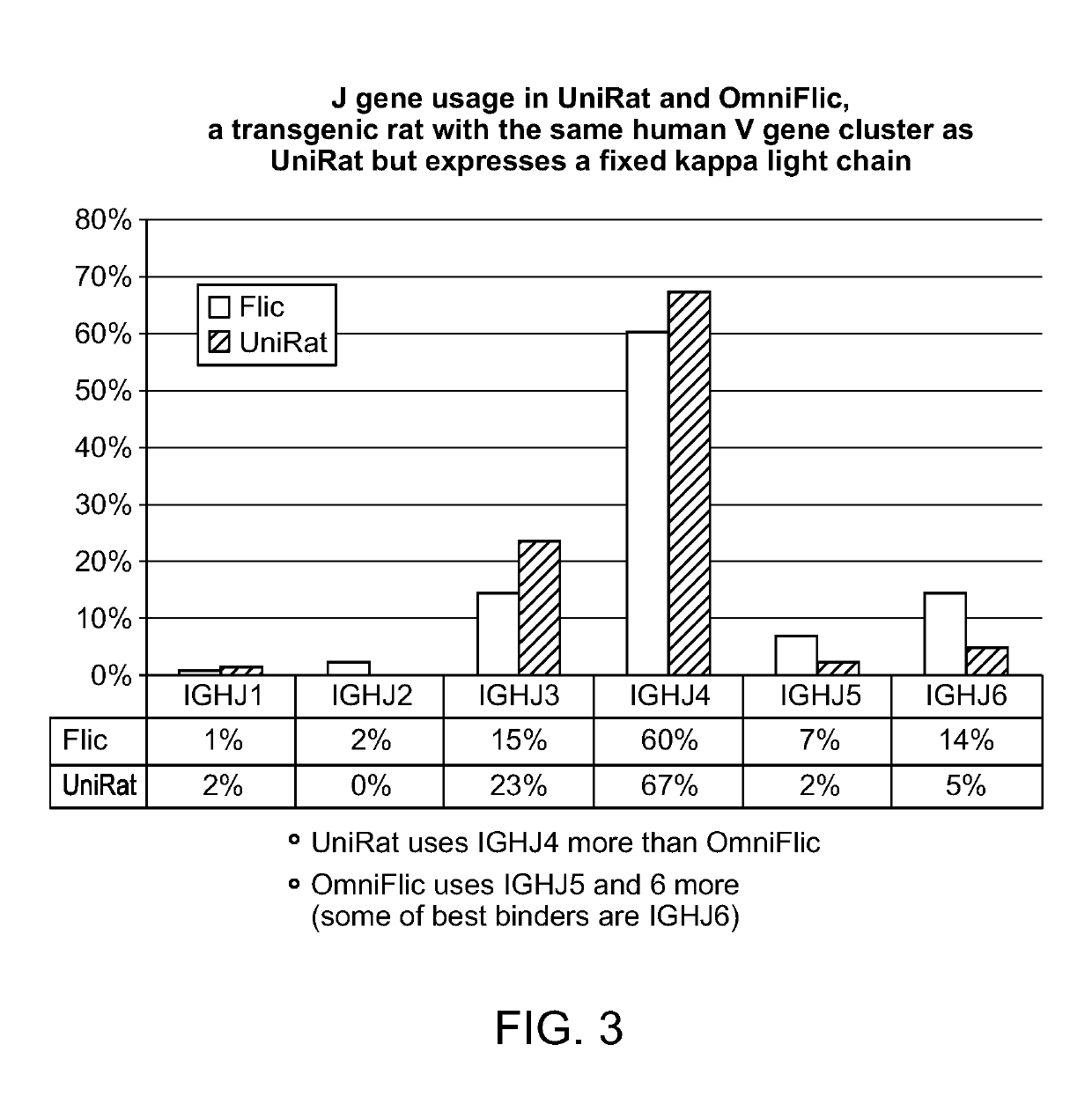Transgenic non-human animals producing modified heavy chain-only antibodies
a technology of heavy chain and non-human animals, which is applied in the field of transgenic non-human animals producing modified heavy chain only antibodies, can solve the problems of domain antibody identified this way that are prone to aggregation and have solubility problems, and achieve the effect of reducing the propensity for aggregation
- Summary
- Abstract
- Description
- Claims
- Application Information
AI Technical Summary
Benefits of technology
Problems solved by technology
Method used
Image
Examples
example 1
n of Genetically Engineered Rats Expressing Heavy Chain-Only Antibodies (HCAbs)
[0118]Previously identified, characterized and, in part, modified BACs and YACs accommodate human heavy chain variable region genes and rat constant region genes (Osborn et al., 2013, J. Immunol. 190:1481-1490; Ma et al., 2013, J. Immunol. Methods 400-401:78-86). To enable heavy-chain antibody expression, a rat constant region BAC was modified by removal of Cμ and deletion of CH1 exons in all Cγs. Heavy-chain-only expression was then enforced by silencing of the endogenous heavy and light chain (kappa and lambda) loci.
[0119]Construction of Modified Human IgH Loci on YACs and BACs.
[0120]A ‘human-rat’ IgH locus was constructed and assembled in several parts. This involved the modification and joining of rat C region genes downstream of human JHs and subsequently, the upstream addition of the human VH6-D-segment region. Two BACs with separate clusters of human VH genes [BAC6 and BAC3] were then co-injected w...
example 2
n of Antigen-Specific Heavy Chain-Only Antibodies (HCAbs) in Rats
[0155]For the generation of antigen-specific heavy chain-only antibodies in rats, genetically engineered rats expressing heavy chain only antibodies, such as those described in Example 1, are immunized in various ways.
[0156]Immunization with Inactivated Virus
[0157]Influenza viruses with various different hemagglutinin and neuraminidase genes is provided by the Immunology and Pathogenesis Branch, Influenza Division, CDC, Atlanta, Ga. Virus stock is propagated in the allantois cavities of 10-day-old embryonated chicken eggs and purified through a 10%-50% sucrose gradient by means of ultracentrifugation. Viruses are resuspended in phosphate-buffered saline and inactivated by treatment with 0.05% formalin at 4° C. for 2 weeks. Inactivated virus and alumn solution (Pierce) are mixed in a 3:1 ratio and incubated at room temperature for 1 h before immunization. Genetically engineered rats expressing heavy chain-only antibodie...
example 3
of Antibody Expressing B Cells from Rats
[0195]Isolation of B Cells from Spleen, Lymph Nodes or Peripheral Blood
[0196]A single-cell suspension is prepared from the spleen or lymph nodes of an immunized rat. Cells can be used without further enrichment, after removal of erythrocytes or after the isolation of B cells, memory B cells, antigen-specific B cells or plasma cells. Enrichment can lead to better results and as a minimum removal of erythrocytes is recommended. Memory B cells are isolated by depletion of unwanted cells and subsequent positive selection. Unwanted cells, for example, T cells, NK cells, monocytes, dendritic cells, granulocytes, platelets, and erythroid cells are depleted using a cocktail of antibodies against CD2, CD14, CD16, CD23, CD36, CD43, and CD235a (Glycophorin A). Positive selection with antibodies specific for IgG or CD19 results in highly enriched B cells (between 50%-95%). Antigen-specific B cells are obtained by exposing cells to antigen(s) tagged with f...
PUM
 Login to View More
Login to View More Abstract
Description
Claims
Application Information
 Login to View More
Login to View More - R&D
- Intellectual Property
- Life Sciences
- Materials
- Tech Scout
- Unparalleled Data Quality
- Higher Quality Content
- 60% Fewer Hallucinations
Browse by: Latest US Patents, China's latest patents, Technical Efficacy Thesaurus, Application Domain, Technology Topic, Popular Technical Reports.
© 2025 PatSnap. All rights reserved.Legal|Privacy policy|Modern Slavery Act Transparency Statement|Sitemap|About US| Contact US: help@patsnap.com



